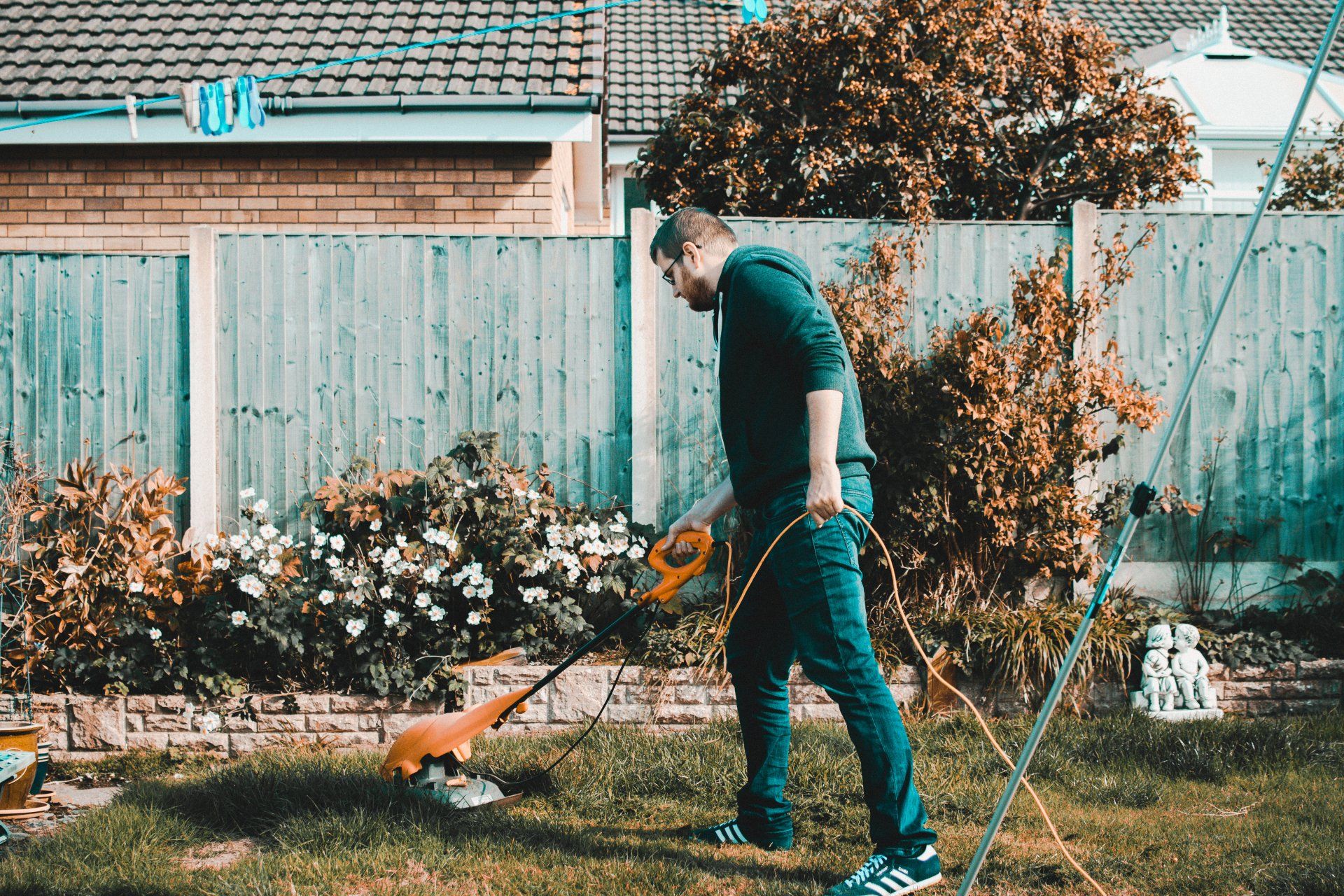KNOWLEDGE CENTER
Affordable Landscaping In Peoria IL

April 3, 2023
Sustainable Landscaping: An Expert Guide to Greening Central Illinois Central Illinois is home to a diverse array of natural landscapes, from prairies to forests and everything in between. Yet, historically, these landscapes have been subjected to harmful practices, such as pesticide and herbicide use, soil erosion, and water pollution. As a result, many homeowners and businesses are now seeking ways to make their landscapes more sustainable and environmentally friendly. Sustainable landscaping is a holistic approach that uses a variety of techniques that promote healthy ecosystems, conserve resources, and reduce waste. In this expert guide, we’ll explore everything you need to know to start greening your outdoor space and join the movement towards a more sustainable Central Illinois. Understanding the impact of traditional landscaping practices on the environment Traditional landscaping practices have often led to negative impacts on the environment. For example, the use of pesticides and herbicides can contaminate soil and water, harming wildlife and potentially posing health risks to humans. Traditional landscaping also often involves significant water usage, which can strain local water resources. In addition, traditional landscaping can contribute to soil erosion and loss of biodiversity. It's important for homeowners and businesses alike to understand the impact that their landscaping practices can have on the environment. Traditional landscaping practices can contribute to a range of environmental concerns, including water pollution, soil erosion, loss of biodiversity, and health risks to both people and wildlife. Fortunately, sustainable landscaping in Peoria IL provides a promising alternative to these negative impacts. By adopting practices such as using native plants, practicing water conservation, and minimizing pesticide and herbicide use, we can create landscapes that are more environmentally friendly and better suited to the local ecosystem. Through sustainable landscaping, we can help to protect natural resources, promote healthy local ecosystems, and create a more livable and sustainable Central Illinois. Sustainable landscaping: What it is and its benefits Sustainable landscaping involves creating outdoor spaces that are both aesthetically pleasing and environmentally responsible. It goes beyond traditional landscaping practices and aims to minimize negative impacts on the environment while maximizing the benefits of a beautiful landscape. Some of the key practices of Peoria IL sustainable landscaping include: Using native plants: Native plants are well-suited to the local climate, require less maintenance, and provide habitat for local wildlife. Practicing water conservation: Sustainable landscaping minimizes water usage through practices like drip irrigation, rainwater harvesting, and using drought-tolerant plants. Minimizing pesticide and herbicide use: Sustainable landscaping avoids or minimizes the use of harmful chemicals, relying instead on natural pest control methods and integrated pest management. Conserving energy: Sustainable landscaping can also help to reduce energy usage by providing shade and insulation to buildings. Composting: Composting yard waste and other organic materials is an important part of sustainable landscaping, reducing the amount of waste going to landfills and providing nutrient-rich soil for plants. The benefits of sustainable landscaping are numerous. By creating landscapes that are more environmentally responsible, we can reduce water usage, minimize pollution, conserve energy, and promote healthy local ecosystems. Sustainable landscaping can also increase property values, enhance curb appeal, and provide a beautiful and enjoyable outdoor space for residents and visitors alike. In Central Illinois, where the climate can be challenging, sustainable landscaping offers an opportunity to create outdoor spaces that are both beautiful and effective at conserving resources and protecting the environment. By adopting practices like using native plants and conserving water, residents and businesses can take an important step toward a more sustainable future. Step-by-step guide to implementing sustainable landscaping in Peoria Il Implementing sustainable landscaping in Central Illinois can seem daunting, but by following these four steps, anyone can create a beautiful outdoor space that is environmentally responsible: Assess your current landscape: Take a look at your current landscape and identify areas where you can make improvements. Consider things like water usage, pesticide and herbicide use, and energy consumption. Assess the types of plants you currently have and determine whether they are native or invasive species. Choose native plants: Choose native plants that are adapted to the local climate and require less maintenance. They also provide habitat for local wildlife and promote biodiversity. There are many resources available to help identify Illinois native plants and where they thrive in Central Illinois. Choose the right plant for the right place: Consider the microclimate of each location before planting. Different plants thrive in various conditions, such as full sun, shade, or even wet soil. By selecting plants that are suited to the local environment, you reduce the amount of water and fertilizer necessary for them to thrive. Conserve water: Use practices such as drip irrigation, Peoria rainwater harvesting , and selecting drought-tolerant plants to minimize water usage. Consider adding features like Peoria Il rain gardens or water features to help manage stormwater runoff. Compost and recycle: Create a composting system to turn yard waste and other organic materials into nutrient-rich soil for plants. Consider recycling materials like plastic containers or metal scraps into garden features or accents. Install a Rain Barrel: A rain barrel collects water from your roof's downspouts and stores it for use in your landscape. By collecting rainwater, you can reduce the amount of municipal water you use for irrigation, which saves on your water bill and conserves resources. Create a Bioswale : A bioswale is a shallow ditch covered with native plants and designed to filter stormwater runoff . It slows the water flow, removes pollutants, and absorbs water. It can be incorporated into the landscape design to create a natural-looking feature. By incorporating Central Illinois native plants and rainwater harvesting, you can create an aesthetically pleasing landscape that is sustainable and environmentally responsible. It also creates a beautiful outdoor space that can be enjoyed for years to come. By following these four steps, anyone can create a sustainable landscape in Central Illinois. Not only will these practices reduce negative impacts on the environment, but they can also save money on water and energy bills while creating a beautiful outdoor space to be enjoyed for years to come. Proper soil management techniques for a healthy and sustainable landscape To create a sustainable and healthy landscape, proper soil management techniques are crucial. Here are some tips to help you maintain your soil health: Conduct Soil Tests: Conduct a soil test to determine nutrient content, pH levels, and organic matter content. This information helps you determine which amendments to use to improve soil fertility. Amend Soil with Organic Matter: Add organic matter to improve soil fertility and increase its water-holding capacity. Compost, leaf mold, and aged manure are excellent organic matter sources. Mulch, Mulch, Mulch: Apply a layer of organic mulch to your garden beds to help retain soil moisture, suppress weed growth, and regulate soil temperature. Avoid Tilling: Excessive tilling can disrupt the soil's natural structure, reducing its ability to hold water and nutrients. Instead, use a broadfork to gently loosen the soil without disturbing its structure. Rotate Crops: Crop rotation helps prevent soil-borne diseases and pests by reducing their build-up in the soil. Use Cover Crops: Cover crops protect the soil from erosion, add organic matter, and increase soil fertility. Legumes such as clover or vetch also add nitrogen to the soil. Use Peoria Il Natural Fertilizers : Amend soils with natural fertilizers such as bone meal, blood meal, or fish emulsion. These natural fertilizers release nutrients slowly, improving soil fertility and reducing the risk of nutrient runoff. By proper soil management techniques, you can maintain a healthy and sustainable landscape that will provide years of enjoyment while conserving vital natural resources. Maintenance tips for an eco-friendly landscape Maintaining a long-lasting and eco-friendly landscape requires more than proper soil management techniques. It involves a holistic approach to managing your landscape sustainably. Here are some additional tips to help you maintain a green and sustainable landscape: Reduce Lawn Size: Lawns require frequent mowing, fertilizers, and pesticides, which are harmful to the environment. Consider reducing your lawn area and replace it with low-maintenance ground covers , shrubs, and trees. Use Peoria Il Integrated Pest Management : Integrated Pest Management (IPM) is a sustainable approach to managing pests without relying on harmful chemicals. It involves using biological control, cultural practices, and selective pesticides only when necessary. Maintaining Garden Equipment : Properly maintain your garden equipment such as lawn mowers, trimmers, and chainsaws to reduce emissions and extend their lifespan. Use electric or battery-powered equipment instead of gas-powered ones whenever possible. Educate Yourself: Keep learning about sustainable landscaping techniques and best practices. Attend workshops, read books, and join local gardening clubs to stay informed and inspired. By following these maintenance tips, you can create a beautiful and sustainable landscape that benefits both you and the environment. Committing to sustainable landscaping and its positive impact on the environment. In conclusion, sustainable landscaping is not only beneficial for the environment but also for your wallet. By implementing eco-friendly techniques in your landscape management, you not only save money but also reduce water usage, prevent pollution, and provide a habitat for wildlife. It requires a commitment to learn and incorporate sustainable gardening practices into your daily routine. Choosing native plants, efficient irrigation systems , reducing lawn size, composting yard waste, using IPM, maintaining garden equipment, and educating yourself are all essential elements of sustainable landscaping. By following these tips, you can enjoy a beautiful and eco-friendly landscape that enhances the natural beauty of Central Illinois. Let's commit to sustainable landscaping and its positive impact on the environment. Looking for an affordable landscaping companies in Peoria ? as one of the best Peoria Il Landscaping Companies , we can help you create the perfect enviro-friendly landscaping project. Call us at 309-271-1455 .

February 6, 2023
Hiring a local Landscape Design Company for your next outdoor project is a big decision, and choosing the best local landscaping company isn't something you should rush through. The landscape of your yard is important, and you want to make sure it’s in good hands. If you plan to hire a local landscape design company , here are 12 things to consider: Company reputation Company reputation – Make sure the company you’re considering has a good reputation. You can check online reviews or ask for recommendations from friends or family. Services offered – What services does the company offer? Do they offer the services you’re looking for? Price – Get quotes from several companies and compare prices. Make sure you’re getting a good value for your money. Experience – How long has the company been in business? How much experience do the employees have? Location – Is the company located near you? This can be important for convenience and cost. References – Ask for references from the company. Make sure to follow up and call the references to ask about their Their landscape design process The landscaping company you hire should have an organized and consistent process for designing the landscape. This process should include: Understanding the needs of the customer – The landscaping company should discuss your needs with you in order to ensure that the design is exactly what you are looking for. Creating a plan – The plan should include detailed diagrams and drawings of the planned landscape layout. The diagrams must be easy to understand and should clearly show the steps needed to complete the project. Follow-up consultation – The landscaping company should make sure that the customer is fully satisfied with the design before starting any work. High quality materials – The landscaping company should only use quality materials in their designs. This will help ensure that the landscape stays in good shape for years to come. Warranties and guarantees – The landscape company should offer warranties and guarantees on their services. This will help protect you from any unexpected issues or problems that may arise. The quality of their past projects You should take the time to research the past projects the landscaping company has completed. Look at the before and after pictures of the projects they have done and take notice of the quality of work they did. This will help you determine if the company’s work is up to your standards. In addition, ask for references from the landscaping company. A good company should be willing to provide you with contact information for some of their past clients. Talking to previous clients will give you an insight on the quality of the work the company did for them. By looking through their past projects, you can determine if this is the type of work you want your landscape to look like. These considerations will help you make an informed decision when hiring a Peoria IL landscaping company. If they actually have experience in the type of work you need If a Peoria IL landscaping company has the type of experience you need, it is important to determine if there are any certifications or awards the company has received for their work. Look for certifications from professional associations, such as associations related to landscape construction or design. Also ask if they hold any awards or recognitions from the community or other larger organizations. This can help you make sure you are hiring a qualified and experienced team to work on your landscaping project. In addition, you should ask the landscaping company how long they have been in business. This will give you an idea of their longevity in the landscaping industry and allow you to gauge their experience regarding specific types of projects. The longer they have been in business, the more likely it is that they are competent and experienced enough to handle the task you need completed. Finally, make sure you research the background of the landscaping company. Make sure that they have a good track record and that they have been compliant with local and state regulations when it comes to landscaping. It is also a good idea to check the Better Business Bureau to make sure there are no unresolved complaints against the company. How comprehensive their estimates are When you’re looking to hire an affordable Peoria IL landscaping company for a project, it is important to make sure that the estimates they provide are comprehensive. Make sure all the materials and other tasks associated with the project are included in their estimates. A comprehensive estimate should include the following items: Type of plants or trees to be used Cost of any irrigation systems, lighting, or other necessary fixtures An estimate for how much soil and amendments will be needed Any rock, stone, or hardscape features to be included Labor costs for installation and other services It is also important to make sure the landscaping company has an appropriate timeline for the project. If the timeline provided by the landscaping company is too long or too short, it is important to bring this up so that this can be resolved before any actual work begins. Additionally, if the landscaping company has a mechanism for tracking progress, make sure to ask about it. Knowing exactly how the project is progressing can put your mind at ease throughout the entire process. If they have good customer service It's also critical to consider the customer service of a Peoria IL landscaping company before hiring them for a project. Find out if they are willing to answer questions, communicate with you regularly throughout the project, and are easy to get a hold of. Good customer service is an essential trait to ask for when researching potential landscaping companies! Other things to consider include: Can they provide a list of references? How long is the turnaround time for customer inquiries? Does the company have landscape designers on staff? Will they help with project ideas and provide advice? How much communication will take place throughout the project? Will the project be discussed or completed virtually? If it's one of the best local landscaping companies and are willing to answer these questions with enthusiasm and provide positive feedback, it’s a good sign that they have excellent customer service. This is an important attribute to consider when hiring a Peoria IL landscaping company ! How well they communicate Good communication is a key factor as well. How often will they provide updates and check in with clients throughout the project? How quickly can they respond to customer inquiries? Being able to contact the company directly should be easy and not a difficult task. Another question to consider is, does the landscaping company have a system in place for listening to the customer’s ideas and concerns throughout the project? Communication is essential to making sure the customer is happy and that all their needs are taken care of. Finally, find out if they offer online project management and communication tools such as chat or video calls. This way, customers can have access to all the conversations and updates online, allowing them to follow the progress of their project closely. Good communication is essential before, during and after any project is completed. Their payment terms Before finalizing the agreement with the landscaping company, also take the time to review their payment terms. How much do they charge for their services? Can they provide estimates in writing? Are there any upfront costs? How often do they need to be paid? Make sure to ask for any hidden costs that may not have been mentioned. Most landscape companies require some kind of payment up front, and that is understandable. It is best to ask for a list of references from previous work, or check out online reviews to see if other customers were pleased with the company’s services. Make sure to proceed with caution if your landscaping company requires full payment up front. What kind of warranty or guarantee they offer It is essential to inquire about the warranties and guarantees the company offers before hiring them. Ask them for a detailed explanation of their warranties and guarantees, such as what procedures they have in place for repairs and replacements, how long their warranty covers, and if they provide any kind of warranty for their landscaping services. Writing down the details of their warranties and guarantees is highly recommended for convenience and added protection. It's important to remember that warranties and guarantees differ from company to company. A reputable landscaping company should offer a clear and comprehensive warranty or guarantee and will be confident in their level of service. Make sure to inquire with multiple companies and read the fine print to get an understanding of the type of warranty they are offering. How large or small the company is When looking for a reputable Peoria IL Landscaping company , it is important to find one that can accommodate your needs. The size of the company you choose will ultimately depend on the kinds of services you are looking for. Smaller landscaping companies tend to have more personalized services for homeowners and small businesses, and are usually more affordable. These companies may not have the resources to create large-scale projects, but they can provide excellent care for routine maintenance. On the other hand, larger landscaping companies may have the resources, experience, and teams necessary to complete large-scale projects, such as complete yard makeovers. They may also be able to provide top-notch services and state-of-the-art equipment. The downside is, they typically cost more than smaller companies. Take the time to ask questions and find a Peoria IL Landscaping Company that meets both your needs and budgeting. To get a good idea of how large a company is, ask about their staff size, the number of customers they have, their experience with certain types of projects, etc. If they use sub-contractors It's important to consider if the company utilizes subcontractors. A good local landscaping company may use subcontractors at times, particularly if they don’t have the manpower or experience to complete certain tasks. By doing so, they can provide an even higher level of service. When asking about subcontractors make sure the company will only be using experienced subcontractors that meet their standards for craftsmanship. A good landscaping company will take the time to vet and make sure they’re only using qualified professionals. It’s also important to inquire about the costs associated with subcontractors. Some landscaping companies charge extra for the use of subcontractors, while others incorporate those costs into their overall price. Understanding all the costs associated with any subcontractors will help you find the most cost-effective landscaping company. Are they insured It's vital to ensure that the landscaping company you hire is properly insured. Landscaping companies are required by law to carry insurance to protect their employees and customers. It is sensible to ask for proof of their insurance when hiring a landscaping company. Make sure you ask specifically about the general liability coverage of any Peoria IL Landscaping company you are considering. General liability insurance covers property damage and bodily injury to a third party in the event of an accident. In addition to general liability coverage, the landscaping companies should also carry workers compensation insurance. It is a form of insurance which covers the medical expenses and lost wages for employees injured on the job. This helps to ensure that the customer is not liable for medical bills or litigation in the event of an employee injury. WIf you have any questions about local lawn care services or local landscaping services , please call us at 309-271-1455
Proudly Serving These Communities: Peoria, East Peoria, Creve Coeur, Pekin, Bartonville, Chillicothe, Dunlap, Morton, Metamora, Washington
Call Today
309-641-2019

Proudly Serving Central Illinois Communities: Peoria, East Peoria, Morton, Pekin, Washington, Bartonville, Dunlap, Chillicothe
PRIVACY POLICY


